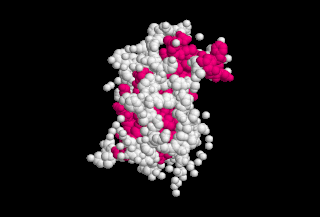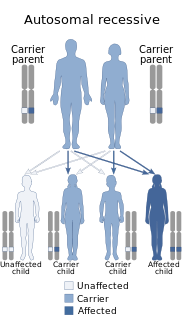 W
WAdiposogenital dystrophy is a condition that may be caused by tertiary hypogonadism originating from decreased levels in GnRH. Low levels of GnRH has been associated with defects of the feeding centers of the hypothalamus, leading to an increased consumption of food and thus caloric intake.
 W
WDwarfism occurs when an organism is extremely small. In humans, it is sometimes defined as an adult height of less than 147 centimetres, regardless of sex; the average adult height among people with dwarfism is 122 centimetres, although some individuals with dwarfism are slightly taller. Disproportionate dwarfism is characterized by either short limbs or a short torso. In cases of proportionate dwarfism, both the limbs and torso are unusually small. Intelligence is usually normal, and most have a nearly normal life expectancy.
 W
WGigantism, also known as giantism, is a condition characterized by excessive growth and height significantly above average. In humans, this condition is caused by over-production of growth hormone in childhood, resulting in people 7 to 9 ft in height.
 W
WGrowth hormone deficiency (GHD) is a medical condition resulting from not enough growth hormone (GH). Generally the most noticeable symptom is that an individual attains a short height. Newborns may also present low blood sugar or a small penis size. In adults there may be decreased muscle mass, high cholesterol levels, or poor bone density.
 W
WHypochondroplasia (HCH) is a developmental disorder caused by an autosomal dominant genetic defect in the fibroblast growth factor receptor 3 gene (FGFR3) that results in a disproportionately short stature, micromelia and a head that appears large in comparison with the underdeveloped portions of the body. It is classified as short-limbed dwarfism.
 W
WJansen's metaphyseal chondrodysplasia (JMC) is a disease that results from ligand-independent activation of the type 1 (PTH1R) of the parathyroid hormone receptor, due to one of three reported mutations.
 W
WKowarski syndrome describes cases of growth failure, despite the presence of normal or slightly high blood growth hormone by radioimmunoassay (RIA-GH) and low serum IGF1, and who exhibit a significant increase in growth rate following recombinant GH therapy.
 W
WLéri–Weill dyschondrosteosis or LWD is a rare pseudoautosomal dominant genetic disorder which results in dwarfism with short forearms and legs and a bayonet-like deformity of the forearms.
 W
WLocal gigantism or localised gigantism is a condition in which a certain part of the body acquires larger than normal size due to excessive growth of the anatomical structures or abnormal accumulation of substances. It is more common in fingers and toes, where it is termed macrodactyly. However, sometimes an entire limb may be enlarged.
 W
WMajewski's polydactyly syndrome, also known as polydactyly with neonatal chondrodystrophy type I, short rib-polydactyly syndrome type II, and shorts rib-polydactyly syndrome, is a lethal form of neonatal dwarfism characterized by osteochondrodysplasia with a narrow thorax, polysyndactyly, disproportionately short tibiae, thorax dysplasia, hypoplastic lungs and respiratory insufficiency. Associated anomalies include protruding abdomen, brachydactyly, peculiar faces, hypoplastic epiglottis, cardiovascular defects, renal cysts, and also genital anomalies. Death occurs before or at birth.
 W
WMicrocephalic osteodysplastic primordial dwarfism type II is a form of dwarfism associated with brain and skeletal abnormalities. It was characterized in 1982.
 W
WMidget is a term for a person of unusually short stature that is considered by some to be pejorative. While not a medical term, it has been applied to persons of unusually short stature, often with the medical condition dwarfism, particularly proportionate dwarfism.
 W
WParastremmatic dwarfism is a rare bone disease that features severe dwarfism, thoracic kyphosis, a distortion and twisting of the limbs, contractures of the large joints, malformations of the vertebrae and pelvis, and incontinence. The disease was first reported in 1970 by Leonard Langer and associates; they used the term parastremmatic from the Greek parastremma, or distorted limbs, to describe it. On X-rays, the disease is distinguished by a "flocky" or lace-like appearance to the bones. The disease is congenital, which means it is apparent at birth. It is caused by a mutation in the TRPV4 gene, located on chromosome 12 in humans. The disease is inherited in an autosomal dominant manner.
 W
WPseudoachondroplasia is an inherited disorder of bone growth. It is a genetic autosomal dominant disorder. It is generally not discovered until 2–3 years of age, since growth is normal at first. Pseudoachondroplasia is usually first detected by a drop of linear growth in contrast to peers, a waddling gait or arising lower limb deformities.
 W
WSilver–Russell syndrome (SRS), also called Silver–Russell dwarfism, is a rare congenital growth disorder. In the United States it is usually referred to as Russell–Silver syndrome (RSS), and Silver–Russell syndrome elsewhere. It is one of 200 types of dwarfism and one of five types of primordial dwarfism.
 W
WStunted growth is a reduced growth rate in human development. It is a primary manifestation of malnutrition and recurrent infections, such as diarrhea and helminthiasis, in early childhood and even before birth, due to malnutrition during fetal development brought on by a malnourished mother. The definition of stunting according to the World Health Organization (WHO) is for the "height for age" value to be less than two standard deviations of the WHO Child Growth Standards median.
 W
WTurner syndrome (TS), also known 45,X, or 45,X0, is a genetic condition in which a female is partly or completely missing an X chromosome. Signs and symptoms vary among those affected. Often, a short and webbed neck, low-set ears, low hairline at the back of the neck, short stature, and swollen hands and feet are seen at birth. Typically, they develop menstrual periods and breasts only with hormone treatment, and are unable to have children without reproductive technology. Heart defects, diabetes, and low thyroid hormone occur more frequently. Most people with TS have normal intelligence. Many have troubles with spatial visualization that may be needed for mathematics. Vision and hearing problems occur more often.